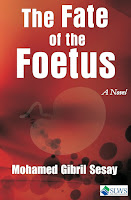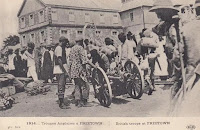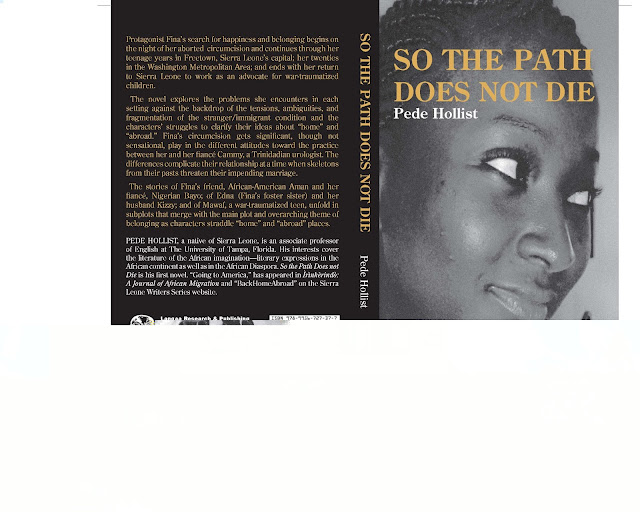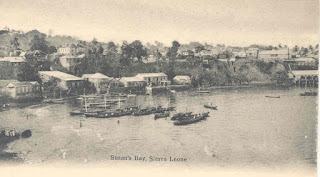A Big-headed Boy Confesses in Mohamed Gibril Sesay's Latest Novel
No doubt about it the book's title is a great hook. The Fate of the Foetus draws in the reader with its striking, blood -red cover. But it's not till you get to the chapter with the same headline as the title that the novel really begins to find its focus.
Mohamed Gibril Sesay's new novel was published early in 2017.
First impressions are always in the eye of the beholder, but I found the book cover quite similar to a National Geographic Channel photo, published by The Guardian in the review of Ian McEwan's new book.
McEwan's “Nutshell” is described as an adaptation of Shakespeare's Hamlet from the perspective of a fetus. In Sesay's comparably-sized novel, however, the fetus isn't the narrator at all.
The spirit talking to us in first-person halfway through Sesay's new book is roaming the universe looking for birth as a human. I dubbed the unidentified spirit a lifetron, a word reportedly coined by Hindu yogi Paramahansa Yogananda to describe the building blocks of life, atoms, electrons, protons, and lifetrons.
“One hot night, I was looking for a way to become partly human when I found Maseray washing in the open spaces of the night and zoomed into her unprotected vulva,” the spirit said matter-of-factly in Sesay's novel. “It was good that I did; for the foetus inside Maseray was already disintegrating, already sliding down the path its other half came,” it added.
After this gut-wrenching introduction, the world-weary a-krifi (Temne word for spirit) rants for several paragraphs, dropping the word “Nuances” ten times before he returns to the krifi world.
According to the National African Language Center at Indiana University, which has made Temne a research area, the Temne of Sierra Leone think spirits (a-krifi) have more influence on their conditions than God.
“The spirits are believed to reside in the wood or bush. As Temne attribute what happens to them to chance or fortune, it is not surprising at all that they have many words conveying “a good krifi” or “a bad krifi,” the Indiana center writes.
The ability to be possessed by another spirit still exists in lots of places in Africa argues Christopher N. Okonkwo in An Abiku-Ogbanje Atlas: A Pre-Text for Rereading Soyinka's Ake and Morrison's Beloved:
“The Yoruba refer to the denizen as abiku; the Igbo call the living icon ogbanje. .... Since abiku/ogbanje evokes the past, with its separations and instability, the concept can serve as a springboard for examining issues of memory, reading in an oral culture, migrations, and conversations (and silences).”
Just as Wole Soyinka in Ake: The Years of Childhood and Toni Morrison in Beloved, exploited the abiku/ogbanje phenomenon, I think Sesay exploited the a-krifi in writing a postwar narrative that he has rooted in Themne mythologies to speak to complex Sierra Leonean relationships.
If "Abiku is a Yoruba state of consciousness regarded with trepidation because of its links with death," a-krifi is the Themne's spirituality.
Although Sesay doesn't give Maimuna's amulet a voice in the following chapter, he does give the talisman enough rope to outdo the "big-headed boy" in the preceding chapter.
Oscar Ronald Dathorne, a Guyanese educator, novelist, poet, and critic, once said of Amos Tutuola that “he deserves to be considered seriously because his work represents an intentional attempt to fuse folklore with modern life.
“In this way, he is unique, not only in Africa, where the sophisticated African writer is incapable of this tenuous and yet controlled connection, but in Europe as well, where this kind of writing is impossible,” Dathorne added.
I think Sesay has achieved what Tutuola did rather haphazardly more than six decades ago in My Life in the Bush of Ghosts.
Sesay's novel doesn't only use “the mythical, the scientific, and sometimes uncomfortable words to narrate,” he accurately portrays the seediness of life in a town, where the founder was called by the name of his Arabic ancestors, "al-Hussein” or The Man from H.U.S.S.E.I.N. To borrow from the Man from Uncle.
Okay, I'm musing.
Like McEwan, I'd say Sesay's "musings are often oblique and tangential with strange scientific questions lurking at its core" as Siddhartha Mukherjee noted in his review “An Unborn Baby Overhears Plans for a Murder in Ian McEwan’s Latest Novel”
But if Temne really means “an old man himself,” I hope to get to read more about the a-krifi and their place in the modern-day world of Sesay's novels, rife with domestic violence, rape, serious abuses, child and maternal deaths, and the long tail of human rights violations in war.
The Fate of the Foetus
By Mohamed Gibril Sesay
114 pp. SLWS/Sierra Leonean Writers Series.
Click here to buy




A stunning comparative analysis of Sesay's novel...a ground breaking novel indeed. Thank you Vitabu..
ReplyDeleteThank you, Walon-Jalloh. Your comment means the world to us.
Delete